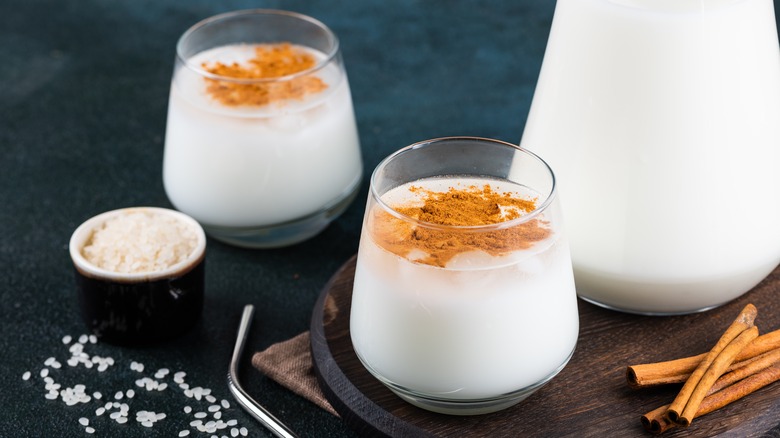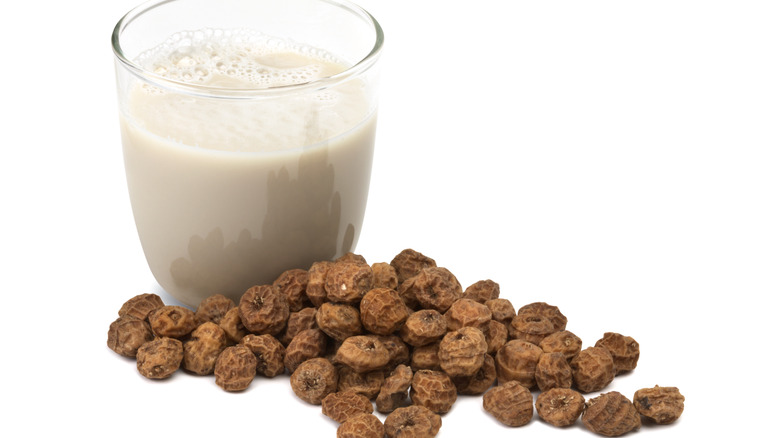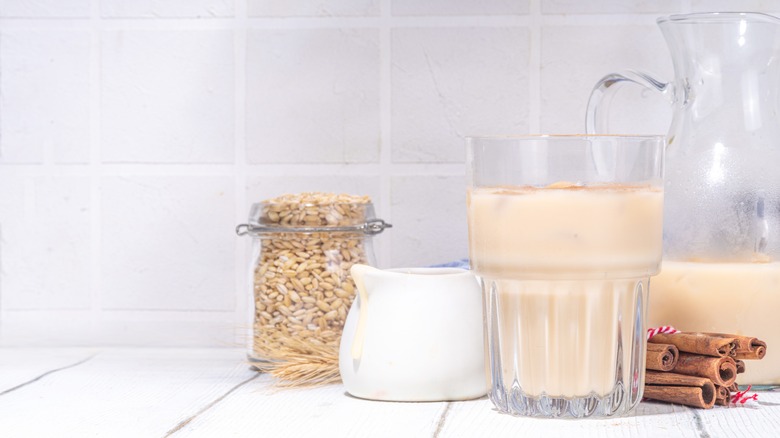What Is Horchata And How Is It Made?
Horchata is arguably the most famous of Mexico's aguas frescas — refreshing drinks made for cooling off on a long, hot day. You can find it at almost any taqueria, where it typically sits in a big plastic container on the counter next to agua de Jamaica and limonada, all ready to be ladled into cups over ice. While most aguas frescas are made from fruits or flowers, with an appearance like juice, horchata is milky white and opaque. It is creamy and sweet, carrying notes of vanilla and cinnamon — a summertime refresher with the flavors of dessert. Mexican horchata is made from rice, but what many people may not realize is that this is not the only kind of horchata. The ingredients used to make them, and the flavors they create can vary substantially depending on where in the world the drink is made.
Horchata may have descended from a North African beverage, introduced to Southern Spain by the Moors. It became extremely popular in the region of Valencia, earning the name we know today. The drink's name can be traced to the Latin "hordeata," which is rooted in the term for barley: "hordeum" (a curious fact, as barley is not typically used to make it). When Spaniards invaded the Americas, they brought a taste for horchata with them, adapting it to local ingredients with the influence of indigenous peoples to reach the great variety we have today.
What goes in horchata?
The ingredients used in horchata vary considerably from country to country, but it is generally made with some form of grain, nut, or seed, soaked in water, blended until smooth, and strained of any lingering solids. Horchata de chufa, the kind made in Valencia, is considered the closest thing to horchata's original form and is made using tiger nuts. The nuts must be soaked in water for many hours until they become soft enough to use. Tiger nuts have a somewhat almond-like taste, which is paired with sugar to sweeten the beverage. Horchata de chufa is noted for its exceptionally creamy texture, which is very similar to that of cow's milk.
Mexican horchata, also known as horchata de arroz, is made in a similar fashion, but it uses soaked grains of rice in place of tiger nuts. The drink is flavored with both sugar and cinnamon, and it is considerably sweeter than horchata de chufa. However, Mexican horchata is not as smooth as its Spanish cousin, and it can sometimes have a slightly mealy texture from the rice. To elevate its creaminess and flavor, milk is sometimes added. Almond milk can be used to keep it vegan, or for an extra-creamy texture, a can of sweetened condensed milk.
Other types of horchata
The versions of horchata made in Mexico and Spain are only the tip of the iceberg. As Spanish influence expanded throughout the Americas, regional variations of the drink developed as people took advantage of local resources. Native Americans and enslaved Africans played a major role in this period of experimentation. In Central American countries such as Honduras and El Salvador, they use jícaro, a.k.a. morro seeds, to make horchata. Derived from a type of calabash, they are toasted before blending into the beverage and have a flavor similar to licorice.
Puerto Rico has its own take on horchata, which is made with sesame seeds. It has a particularly nutty flavor with a slightly bitter finish and an incredibly smooth and creamy texture. While some recipes do contain spices such as cloves, cinnamon, and star anise for flavoring, Puerto Rican horchata often keeps it simple with just sesame seeds, water, and sugar.
Horchata Lojana, is prepared in Ecuador's Loja province. Other horchata varieties are made from some kind of grain, nut, or seed, but horchata Lojana is made with herbs. It is not thick and creamy but is instead tea-like. Ecuadorian horchata can contain around 20 to 30 different herbs, although the combination varies depending on seasonal availability. Lemon verbena, purslane, and basil are standards. It boasts a signature red color that comes from bloodleaf. Horchata Lojana has long been consumed for medicinal purposes, as well as a warm-weather refreshment.


